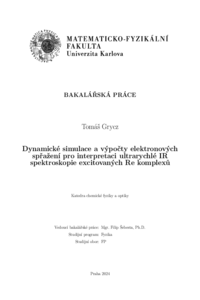Dynamické simulace a výpočty elektronových spřažení pro interpretaci ultrarychlé IR spektroskopie excitovaných Re komplexů
Dynamic simulations and calculations of electronic couplings for interpretation of ultrafast IR spectroscopy of excited Re complexes
bakalářská práce (OBHÁJENO)

Zobrazit/
Trvalý odkaz
http://hdl.handle.net/20.500.11956/191423Identifikátory
SIS: 267156
Kolekce
- Kvalifikační práce [11342]
Autor
Vedoucí práce
Oponent práce
Záliš, Stanislav
Fakulta / součást
Matematicko-fyzikální fakulta
Obor
Fyzika
Katedra / ústav / klinika
Katedra chemické fyziky a optiky
Datum obhajoby
19. 6. 2024
Nakladatel
Univerzita Karlova, Matematicko-fyzikální fakultaJazyk
Čeština
Známka
Výborně
Klíčová slova (česky)
QM, MM MD|DFT|elektronová spřažení|Re komplexy|excitované stavyKlíčová slova (anglicky)
QM, MM MD|DFT|elektronic couplings|Re complexes|excited statesV této práci využíváme metod kvantové chemie a molekulové dynamiky k interpretaci výsledků spektroskopie dvou rheniových donor-akceptorových komplexů ReCl(CO)3(N,N'-4-((4-(difenylamino)fenyl)karbamoyl)-2,2'-bipyridin) a ReCl(CO)3(N,N'-5-((4-(difenylamino)fenyl)karbamoyl)-2,2'-bipyridin) po excitaci ultra- krátkým laserovým pulsem v blízké UV oblasti. Konkrétně se zde zaměřujeme na přenos mezi stavem s 3 MLCT/3 IL charakterem a 3 CS a na vysvětlení, proč je u druhého komplexu rychlejší. Struktury komplexů v základním a 3 MLCT stavu byly získány z klasických a QM/MM MD simulací v dimetylsulfoxidu ve formě explicitního rozpouštědla. U získa- ných struktur byly analyzovány geometrické parametry, rozložení elektronové hustoty a vliv elektrostatického působení rozpouštědla. Ovlivnění rychlosti přenosu elektronu bylo odhadováno na základě velikosti elektronových spřažení. Ukazuje se, že vzhledem k jejich velikosti (pro GS ∼ 25 meV), je průběh elektronového přenosu spíše adiabatický. Sta- novené elektrostatické potenciály ukazují na důležitost vlivu rozpouštědla při stabilizaci 3 CS a 3 MLCT stavů, kdy se změny potenciálu nejvíce projevují v okolí bpy. 1
In this thesis we make use of methods applied in quantum chemistry and molecular dynamics to interpret the results of the spectroscopy of two rhenium donor-acceptor com- plexes ReCl(CO)3 (N,N'-4-((4-(diphenyl)phenyl)carbamoyl)-2,2'-bipiridine) and ReCl(CO)3 (N,N'-5-((4-(diphenyl)phenyl)carbamoyl)-2,2'-bipiridine) after exciting them with a ul- trashort laser pulse in the near UV range. Specifically we concentrate on the transition between the state with the character of 3 MLCT/3 IL and 3 CS, and why it is faster for the latter. The structures of the complexes in the ground state and the 3 MLCT state were obtained from the classical and QM/MM MD simulations in dimethyl sulfoxide in the form of an explicit solvent. The geometrical parameters, electron density distribution and the electrostatic effect of the solvent were analysed from the acquired structures. Their influence on the rate of the electron transmission was estimated based on the value of the electronic coupling. It is shown that due to their size ( 25 meV for GS), the process of transition of the electron was mostly adiabatic. Determined electrostatic potentials show the crucial effect of the solvent during the stabilisation of the 3 CS and 3 MLCT states, where the changes in the potential are the largest in the area around bpy. 1
